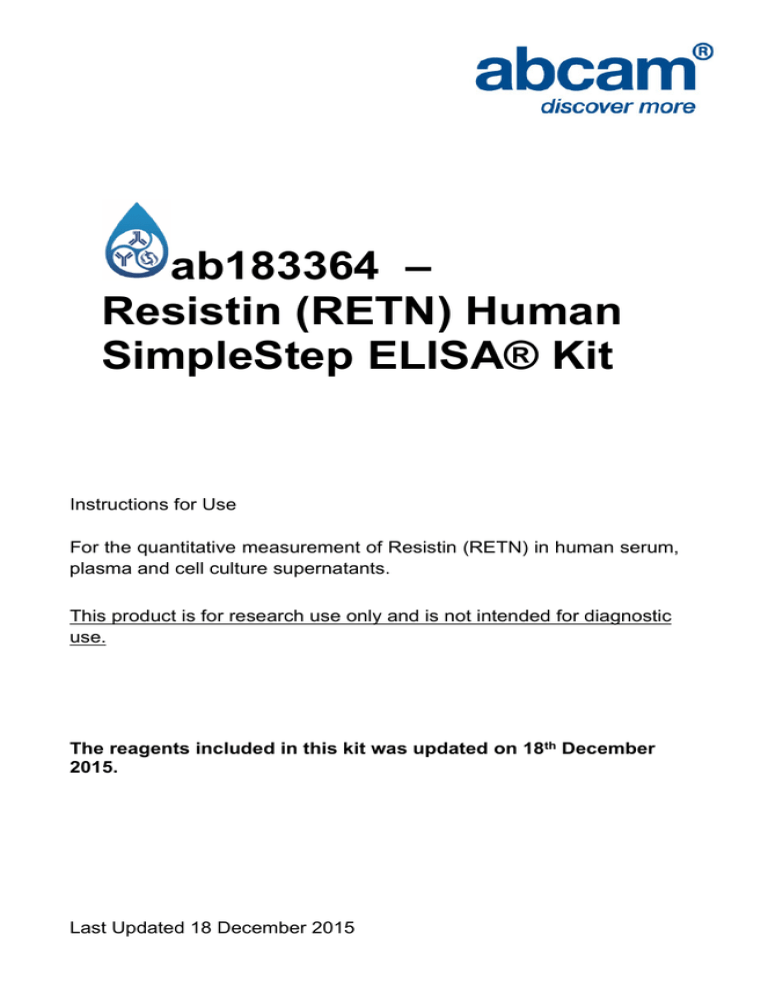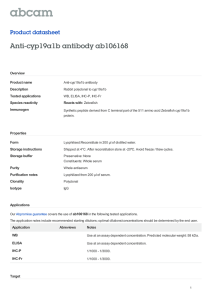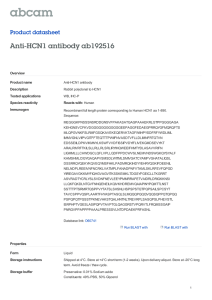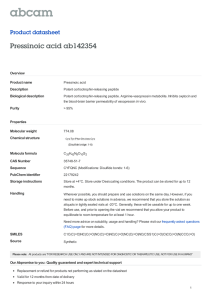
ab183364 –
Resistin (RETN) Human
SimpleStep ELISA® Kit
Instructions for Use
For the quantitative measurement of Resistin (RETN) in human serum,
plasma and cell culture supernatants.
This product is for research use only and is not intended for diagnostic
use.
The reagents included in this kit was updated on 18th December
2015.
Last Updated 18 December 2015
Table of Contents
INTRODUCTION
1.
2.
BACKGROUND
ASSAY SUMMARY
2
4
GENERAL INFORMATION
3.
4.
5.
6.
7.
8.
PRECAUTIONS
STORAGE AND STABILITY
MATERIALS SUPPLIED
MATERIALS REQUIRED, NOT SUPPLIED
LIMITATIONS
TECHNICAL HINTS
5
5
5
6
6
6
ASSAY PREPARATION
9.
10.
11.
12.
REAGENT PREPARATION
STANDARD PREPARATION
SAMPLE PREPARATION
PLATE PREPARATION
8
9
10
11
ASSAY PROCEDURE
13.
ASSAY PROCEDURE
12
DATA ANALYSIS
14.
15.
16.
17.
18.
CALCULATIONS
TYPICAL DATA
TYPICAL SAMPLE VALUES
ASSAY SPECIFICITY
SPECIES REACTIVITY
14
15
17
20
20
RESOURCES
19.
20.
TROUBLESHOOTING
NOTES
Discover more at www.abcam.com
21
22
1
INTRODUCTION
1.
BACKGROUND
Abcam’s Resistin (RETN) in vitro SimpleStep ELISA® (Enzyme-Linked
Immunosorbent Assay) kit is designed for the quantitative
measurement of Resistin protein in human serum, plasma and cell
culture supernatants.
The SimpleStep ELISA® employs an affinity tag labeled capture
antibody and a reporter conjugated detector antibody which
immunocapture the sample analyte in solution. This entire complex
(capture antibody/analyte/detector antibody) is in turn immobilized via
immunoaffinity of an anti-tag antibody coating the well. To perform the
assay, samples or standards are added to the wells, followed by the
antibody mix. After incubation, the wells are washed to remove
unbound material. TMB substrate is added and during incubation is
catalyzed by HRP, generating blue coloration. This reaction is then
stopped by addition of Stop Solution completing any color change from
blue to yellow. Signal is generated proportionally to the amount of
bound analyte and the intensity is measured at 450 nm. Optionally,
instead of the endpoint reading, development of TMB can be recorded
kinetically at 600 nm.
Resistin, otherwise known as Found in Inflammatory Zone 3 (FIZZ3),
and Adipocyte Secreted Factor (ADSF), is a 114 amino-acid cysteinerich protein. It can be found as a high molecular weight hexamer or as
a more active, lower molecular weight complex. Resistin is the best
known member of the family of Resistin-like Molecules (RELMs), which
include RELM-alpha/FIZZ1 and RELM-beta/FIZZE 2, both described
only in rodents. Furthermore, resistin has been categorized as part of
the group of adipokines hormones, which are known to be involved in
the development of obesity, insulin resistance, diabetes, inflammation,
autoimmune disease and metabolic syndrome.
In Humans, Resistin is a pro-inflammatory molecule primarily secreted
by macrophages and mononuclear bone marrow cells in response to
Discover more at www.abcam.com
2
INTRODUCTION
inflammation, hyperglycemia, and growth hormones. IL-1, IL-6, TNFalpha as well as lipopolysaccharide (LPS) are strong inducers of
resistin as observed in animal models of hepatic inflammation and
necrosis. High levels of resistin are also observed in patients with
pancreatitis and with systemic lupus erythematosus.
Beyond its role as a pro-inflamatory molecule, resistin has been found
to have a metabolic function due to its expression in other tissues such
as white adipose tissue, placenta, uterus, skeletal muscle, GI tract,
spleen, thyroid gland and pancreas. Metabolically, elevated levels of
resistin are associated with glucose intolerance, hyperinsulinemia, and
insulin resistance. These effects are believed to be consequential to
dephosphorylation of AMPK in the liver and overexpression of
Suppressor of cytokine signaling 3 (SOCS-3) in the pancreatic beta
cells. Furthermore, the levels of resistin in serum have been found to
positively correlate with increased body fat content, which may be
explained by its ability to induce adipocyte proliferation and
angiogenesis. Despite the effects of resistin on insulin resistance,
glycemic levels and body fat content, the role of resistin linking obesity
to diabetes continues to be controversial.
Discover more at www.abcam.com
3
INTRODUCTION
2. ASSAY SUMMARY
Remove appropriate number of
antibody coated well strips.
Equilibrate all reagents to room
temperature.
Prepare all
reagents,
samples,
and
standards as instructed.
Add standard or sample to
appropriate wells.
Add Antibody Cocktail to all
wells.
Incubate
at
room
temperature.
Aspirate and wash each well.
Add TMB Substrate to each well
and incubate. Add Stop Solution
at
a
defined
endpoint.
Alternatively,
record
color
development kinetically after
TMB substrate addition.
Discover more at www.abcam.com
4
GENERAL INFORMATION
3. PRECAUTIONS
Please read these instructions carefully prior to beginning the
assay.
All kit components have been formulated and quality control tested to
function successfully as a kit. Modifications to the kit components or
procedures may result in loss of performance.
4. STORAGE AND STABILITY
Store kit at 2-8ºC immediately upon receipt.
Refer to list of materials supplied for storage conditions of individual
components. Observe the storage conditions for individual prepared
components in sections 9 & 10.
5. MATERIALS SUPPLIED
10X Resistin Capture Antibody
600 µL
Storage
Condition
(Before
Preparation)
+2-8ºC
10X Resistin Detector Antibody
Resistin Human Lyophilized Recombinant
Protein
Antibody Diluent CPI
600 µL
+2-8ºC
2 Vials
+2-8ºC
6 mL
+2-8ºC
10X Wash Buffer PT
20 mL
+2-8ºC
TMB Substrate
12 mL
+2-8ºC
Stop Solution
12 mL
+2-8ºC
Sample Diluent NS
Pre-Coated 96 Well Microplate (12 x 8 well
strips)
Plate Seal
50 mL
+2-8ºC
96 Wells
+2-8ºC
1
+2-8ºC
Item
Discover more at www.abcam.com
Amount
5
GENERAL INFORMATION
6. MATERIALS REQUIRED, NOT SUPPLIED
These materials are not included in the kit, but will be required to
successfully utilize this assay:
Microplate reader capable of measuring absorbance at 450 or
600 nm.
Method for determining protein concentration (BCA assay
recommended).
Deionized water.
PBS (1.4 mM KH2PO4, 8 mM Na2HPO4, 140 mM NaCl,
2.7 mM KCl, pH 7.4).
Multi- and single-channel pipettes.
Tubes for standard dilution.
Plate shaker for all incubation steps.
Phenylmethylsulfonyl
inhibitors).
Fluoride
(PMSF)
(or
other
protease
7. LIMITATIONS
Assay kit intended for research use only. Not for use in diagnostic
procedures.
Do not mix or substitute reagents or materials from other kit lots or
vendors. Kits are QC tested as a set of components and
performance cannot be guaranteed if utilized separately or
substituted.
8. TECHNICAL HINTS
Samples generating values higher than the highest standard
should be further diluted in the appropriate sample dilution buffers.
Avoid foaming
components.
Avoid cross contamination of samples or reagents by changing tips
between sample, standard and reagent additions.
or
bubbles
Discover more at www.abcam.com
when
mixing
or
reconstituting
6
GENERAL INFORMATION
Ensure plates are properly sealed or covered during incubation
steps.
Complete removal of all solutions and buffers during wash steps is
necessary to minimize background.
As a guide, typical ranges of sample concentration for commonly
used sample types are shown below in Sample Preparation
(section 11).
All samples should be mixed thoroughly and gently.
Avoid multiple freeze/thaw of samples.
Incubate ELISA plates on a plate shaker during all incubation
steps.
When generating positive control samples, it is advisable to
change pipette tips after each step.
The provided 5X Cell Extraction Buffer contains phosphatase
inhibitors. Protease inhibitors can be added if required.
The provided 50X Cell Extraction Enhancer Solution may
precipitate when stored at + 4ºC. To dissolve, warm briefly at
+ 37ºC and mix gently. The 50X Cell Extraction Enhancer Solution
can be stored at room temperature to avoid precipitation.
To avoid high background always add samples or standards
to the well before the addition of the antibody cocktail.
This kit is sold based on number of tests. A ‘test’ simply
refers to a single assay well. The number of wells that
contain sample, control or standard will vary by product.
Review the protocol completely to confirm this kit meets your
requirements. Please contact our Technical Support staff
with any questions.
Discover more at www.abcam.com
7
ASSAY PREPARATION
9. REAGENT PREPARATION
Equilibrate all reagents to room temperature (18-25°C) prior to
use. The kit contains enough reagents for 96 wells. The sample
volumes below are sufficient for 48 wells (6 x 8-well strips);
adjust volumes as needed for the number of strips in your
experiment.
Prepare only as much reagent as is needed on the day of the
experiment. Capture and Detector Antibodies have only been
tested for stability in the provided 10X formulations.
9.1
1X Wash Buffer PT
Prepare 1X Wash Buffer PT by diluting 10X Wash Buffer PT
with deionized water. To make 50 mL 1X Wash Buffer PT
combine 5 mL 10X Wash Buffer PT with 45 mL deionized
water. Mix thoroughly and gently.
9.2
Antibody Cocktail
Prepare Antibody Cocktail by diluting the capture and
detector antibodies in Antibody Diluent CPI. To make 3 mL
of the Antibody Cocktail combine 300 µL 10X Capture
Antibody and 300 µL 10X Detector Antibody with 2.4 mL
Antibody Diluent CPI. Mix thoroughly and gently.
Discover more at www.abcam.com
8
ASSAY PREPARATION
10. STANDARD PREPARATION
Prepare serially diluted standards immediately prior to use. Always
prepare a fresh set of positive controls for every use.
The following section describes the preparation of a standard curve for
duplicate measurements (recommended).
10.1 Reconstitute the Resistin standard sample by adding 100 µL
water by pipette. Mix thoroughly and gently. Hold at room
temperature for 10 minutes and mix gently. This is the
100,000 pg/mL Stock Standard Solution (see table below).
10.2 Label eight tubes with numbers 1 – 8.
10.3 Add 380 μL Sample Diluent NS into tube #1 and 150 μL
Sample Diluent NS into tube numbers 2-8.
10.4 Use the Stock Standard to prepare the following dilution
series. Standard #8 contains no protein and is the Blank
control:
20 µL
150 µL 150 µL 150 µL 150 µL 150 µL 150 µL
µ
100,000
pg/mL
5,000
pg/mL
µ
µ
µ
625
2,500 1,250
312.5
pg/mL pg/mL pg/mL pg/mL
Discover more at www.abcam.com
µ
µ
0
156.3
78.1
pg/mL pg/mL pg/mL
9
ASSAY PREPARATION
11. SAMPLE PREPARATION
TYPICAL SAMPLE DYNAMIC RANGE
Sample Type
Range (%)
Normal Human Serum
12.5 – 100
Normal Human Plasma - Citrate
12.5 – 100
Normal Human Plasma - Heparin
12.5 – 100
Normal Human Plasma - EDTA
12.5 – 100
Cell culture media
12.5 – 100
11.1 Plasma
Collect plasma using citrate, EDTA or heparin. Centrifuge
samples at 2,000 x g for 10 minutes. Dilute samples into
Sample Diluent NS and assay. Store un-diluted plasma
samples at -20ºC or below for up to 3 months. Avoid
repeated freeze-thaw cycles.
11.2 Serum
Samples should be collected into a serum separator tube.
After clot formation, centrifuge samples at 2,000 x g for 10
minutes and collect serum. Dilute samples into Sample
Diluent NS and assay. Store un-diluted serum at -20ºC or
below. Avoid repeated freeze-thaw cycles.
11.3 Cell Culture Supernatants
Centrifuge cell culture media at 2,000 x g for 10 minutes to
remove debris. If necessary, dilute supernatants in nonreactive cell culture media and assay. Store samples at 20°C or below. Avoid repeated freeze-thaw cycles.
Discover more at www.abcam.com
10
ASSAY PREPARATION
12. PLATE PREPARATION
The 96 well plate strips included with this kit are supplied ready to
use. It is not necessary to rinse the plate prior to adding reagents.
Unused plate strips should be immediately returned to the foil
pouch containing the desiccant pack, resealed and stored at 4°C.
For each assay performed, a minimum of two wells must be used
as the zero control.
For statistical reasons, we recommend each sample should be
assayed with a minimum of two replicates (duplicates).
Differences in well absorbance or “edge effects” have not been
observed with this assay.
Discover more at www.abcam.com
11
ASSAY PROCEDURE
13. ASSAY PROCEDURE
Equilibrate all materials and prepared reagents to room
temperature prior to use.
It is recommended to assay all standards, controls and
samples in duplicate.
13.1 Prepare all reagents, working standards, and samples as
directed in the previous sections.
13.2 Remove excess microplate strips from the plate frame,
return them to the foil pouch containing the desiccant pack,
reseal and return to 4ºC storage.
13.3 Add 50 µL of all sample or standard to appropriate wells.
13.4 Add 50 µL of the Antibody Cocktail to each well.
13.5 Seal the plate and incubate for 1 hour at room temperature
on a plate shaker set to 400 rpm.
13.6 Wash each well with 3 x 350 µL 1X Wash Buffer PT. Wash
by aspirating or decanting from wells then dispensing 350 µL
1X Wash Buffer PT into each well. Complete removal of
liquid at each step is essential for good performance. After
the last wash invert the plate and blot it against clean paper
towels to remove excess liquid.
13.7 Add 100 µL of TMB Substrate to each well and incubate for
10 minutes in the dark on a plate shaker set to 400 rpm.
13.8 Add 100 µL of Stop Solution to each well. Shake plate on a
plate shaker for 1 minute to mix. Record the OD at 450 nm.
This is an endpoint reading.
Alternative to 13.7 – 13.8: Instead of the endpoint reading at
450 nm, record the development of TMB Substrate
kinetically. Immediately after addition of TMB Development
Solution begin recording the blue color development with
elapsed time in the microplate reader prepared with the
following settings:
Discover more at www.abcam.com
12
ASSAY PROCEDURE
Mode:
Kinetic
Wavelength:
600 nm
Time:
up to 15 min
Interval:
20 sec - 1 min
Shaking:
Shake between readings
Note that an endpoint reading can also be recorded at the
completion of the kinetic read by adding 100 µL Stop
Solution to each well and recording the OD at 450 nm.
13.9 Analyze the data as described below.
Discover more at www.abcam.com
13
DATA ANALYSIS
14. CALCULATIONS
14.1 Calculate the average absorbance value for the blank control
(zero) standards. Subtract the average blank control
standard absorbance value from all other absorbance
values.
14.2 Create a standard curve by plotting the average blank
control subtracted absorbance value for each standard
concentration (y-axis) against the target protein
concentration (x-axis) of the standard. Use graphing
software to draw the best smooth curve through these points
to construct the standard curve.
Note: Most microplate reader software or graphing software
will plot these values and fit a curve to the data. A four
parameter curve fit (4PL) is often the best choice; however,
other algorithms (e.g. linear, semi-log, log/log, 4 parameter
logistic) can also be tested to determine if it provides a better
curve fit to the standard values.
14.3 Determine the concentration of the target protein in the
sample by interpolating the blank control subtracted
absorbance values against the standard curve. Multiply the
resulting value by the appropriate sample dilution factor, if
used, to obtain the concentration of target protein in the
sample.
14.4 Samples generating absorbance values greater than that of
the highest standard should be further diluted and
reanalyzed. Similarly, samples which measure at an
absorbance values less than that of the lowest standard
should be retested in a less dilute form.
Discover more at www.abcam.com
14
DATA ANALYSIS
15. TYPICAL DATA
TYPICAL STANDARD CURVE – Data provided for demonstration
purposes only. A new standard curve must be generated for each
assay performed.
Standard Curve Measurements
Conc.
O.D. 450 nm
Mean
(pg/mL)
1
2
O.D.
0
0.081
0.081
0.081
78.1
0.116
0.116
0.116
156.3
0.167
0.162
0.165
312.5
0.248
0.248
0.248
625
0.423
0.418
0.420
1,250
0.766
0.765
0.765
2,500
1.391
1.422
1.406
5,000
2.542
2.545
2.543
Figure 1. Example of Resistin standard curve in Sample Diluent NS. The
Resistin standard curve was prepared as described in Section 10. Raw data
values are shown in the table. Background-subtracted data values (mean +/SD) are graphed.
Discover more at www.abcam.com
15
DATA ANALYSIS
Standard Curve Measurements
Conc.
O.D. 450 nm
Mean
(pg/mL)
1
2
O.D.
0
0.052
0.052
0.052
78.1
0.079
0.079
0.079
156.3
0.105
0.109
0.107
312.5
0.165
0.164
0.165
625
0.260
0.258
0.259
1,250
0.446
0.454
0.450
2,500
0.788
0.740
0.764
5,000
1.478
1.492
1.485
Figure 2. Example of Resistin standard curve in cell culture media. The
Resistin standard curve was prepared as described in Section 10. Raw data
values are shown in the table. Background-subtracted data values (mean +/SD) are graphed.
Discover more at www.abcam.com
16
DATA ANALYSIS
16. TYPICAL SAMPLE VALUES
SENSITIVITY –
The calculated minimal detectable (MDD) dose is 24 pg/mL. The MDD
was determined by calculating the mean of zero standard replicates
(n=40) and adding 2 standard deviations then extrapolating the
corresponding concentrations.
RECOVERY –
Three concentrations of Resistin were spiked in duplicate to the
indicated biological matrix to evaluate signal recovery in the working
range of the assay.
Sample Type
100% Normal Human Serum
100% Normal Human Plasma - Citrate
100% Normal Human Plasma - EDTA
100% Normal Human Plasma - Heparin
Cell Culture Media
Discover more at www.abcam.com
Average %
Recovery
94
78
96
95
106
Range (%)
88 - 100
68 -90
88 - 104
84 - 110
106 - 107
17
DATA ANALYSIS
LINEARITY OF DILUTION –
Linearity of dilution is determined based on interpolated values from
the standard curve. Linearity of dilution defines a sample
concentration interval in which interpolated target concentrations are
directly proportional to sample dilution.
Recombinant Resistin was spiked into the following biological samples
and diluted in a 2-fold dilution series in Sample Diluent NS.
100%
100%
Human
Interpolated value Human
Plasma
Serum
(Citrate)
pg/mL
2,567.8 2,421.8
Undiluted
% Expected value
100
100
pg/mL
1,302.8 1,387.9
2
% Expected value
101
115
pg/mL
701.8
584.0
4
% Expected value
109
96
pg/mL
362.5
337.5
8
% Expected value
113
111
Dilution
Factor
100%
100%
100%
Human Human
cell culture
Plasma Plasma
media
(EDTA) (Heparin)
2,688.0 2,789.9
3161.4
100
100
100
1,435.2 1,387.9
1,499.4
107
108
95
674.5
583.9
630.3
100
120
80
375.3
442.4
365.6
112
142
93
PRECISION –
Mean coefficient of variations of interpolated values from 3
concentrations of serum within the working range of the assay.
n=
CV (%)
IntraAssay
9
3
Discover more at www.abcam.com
InterAssay
3
6
18
DATA ANALYSIS
Figure 3. Levels of Resistin in normal serum. The levels of native Resistin in
serum samples were tested from ten individual healthy donors. Levels were
interpolated from the standard curve in Sample Diluent NS. The mean level of
Resistin was 2.6 ng/mL with a range of 1.6 to 5.3 ng/mL and a standard
deviation of 1 ng/mL.
Discover more at www.abcam.com
19
DATA ANALYSIS
17. ASSAY SPECIFICITY
This assay recognizes native and recombinant human Resistin protein.
Cross-reactivity was tested with human Leptin recombinant protein
prepared at 50ng/mL in Sample Diluent NS. No significant crossreactivity was observed with OD deviation from background of 0.019.
Similarly, recombinant human Resistin protein was assayed at
1,000 pg/mL in the presence and absence of 50 ng/mL of human
Leptin to determine interference. Recovery of Resistin was observed
at 103% with a standard deviation of 1%.
18. SPECIES REACTIVITY
This kit recognizes both native and recombinant human Resistin
protein in the serum, plasma, and cell culture supernatants only.
Mouse and rat serum and plasma samples have not been tested with
this kit.
Please contact our Technical Support team for more information.
Discover more at www.abcam.com
20
RESOURCES
19. TROUBLESHOOTING
Problem
Cause
Solution
Difficulty pipetting
lysate; viscous
lysate.
Genomic DNA
solubilized
Prepare 1X Cell Extraction
Buffer PTR (without
enhancer). Add enhancer to
lysate after extraction.
Inaccurate Pipetting
Check pipettes
Improper standard
dilution
Prior to opening, briefly spin
the stock standard tube and
dissolve the powder
thoroughly by gentle mixing
Incubation times too
brief
Ensure sufficient incubation
times; increase to 2 or 3 hour
standard/sample incubation
Inadequate reagent
volumes or improper
dilution
Check pipettes and ensure
correct preparation
Incubation times with
TMB too brief
Ensure sufficient incubation
time until blue color develops
prior addition of Stop solution
Plate is insufficiently
washed
Review manual for proper
wash technique. If using a
plate washer, check all ports
for obstructions.
Contaminated wash
buffer
Prepare fresh wash buffer
Improper storage of
the ELISA kit
Store your reconstituted
standards at -80°C, all other
assay components 4°C.
Keep TMB substrate solution
protected from light.
Poor standard
curve
Low Signal
Large CV
Low sensitivity
Discover more at www.abcam.com
21
RESOURCES
20. NOTES
Discover more at www.abcam.com
22
UK, EU and ROW
Email: technical@abcam.com | Tel: +44-(0)1223-696000
Austria
Email: wissenschaftlicherdienst@abcam.com | Tel: 019-288-259
France
Email: supportscientifique@abcam.com | Tel: 01-46-94-62-96
Germany
Email: wissenschaftlicherdienst@abcam.com | Tel: 030-896-779-154
Spain
Email: soportecientifico@abcam.com | Tel: 911-146-554
Switzerland
Email: technical@abcam.com
Tel (Deutsch): 0435-016-424 | Tel (Français): 0615-000-530
US and Latin America
Email: us.technical@abcam.com | Tel: 888-77-ABCAM (22226)
Canada
Email: ca.technical@abcam.com | Tel: 877-749-8807
China and Asia Pacific
Email: hk.technical@abcam.com | Tel: 108008523689 (中國聯通)
Japan
Email: technical@abcam.co.jp | Tel: +81-(0)3-6231-0940
www.abcam.com | www.abcam.cn | www.abcam.co.jp
Copyright © 2015 Abcam, All Rights Reserved. The Abcam logo is a registered trademark.
All information / detail is correct at time of going to print.
RESOURCES
23




![Anti-CD300e antibody [UP-H2] ab188410 Product datasheet Overview Product name](http://s2.studylib.net/store/data/012548866_1-bb17646530f77f7839d58c48de5b1bb7-300x300.png)

